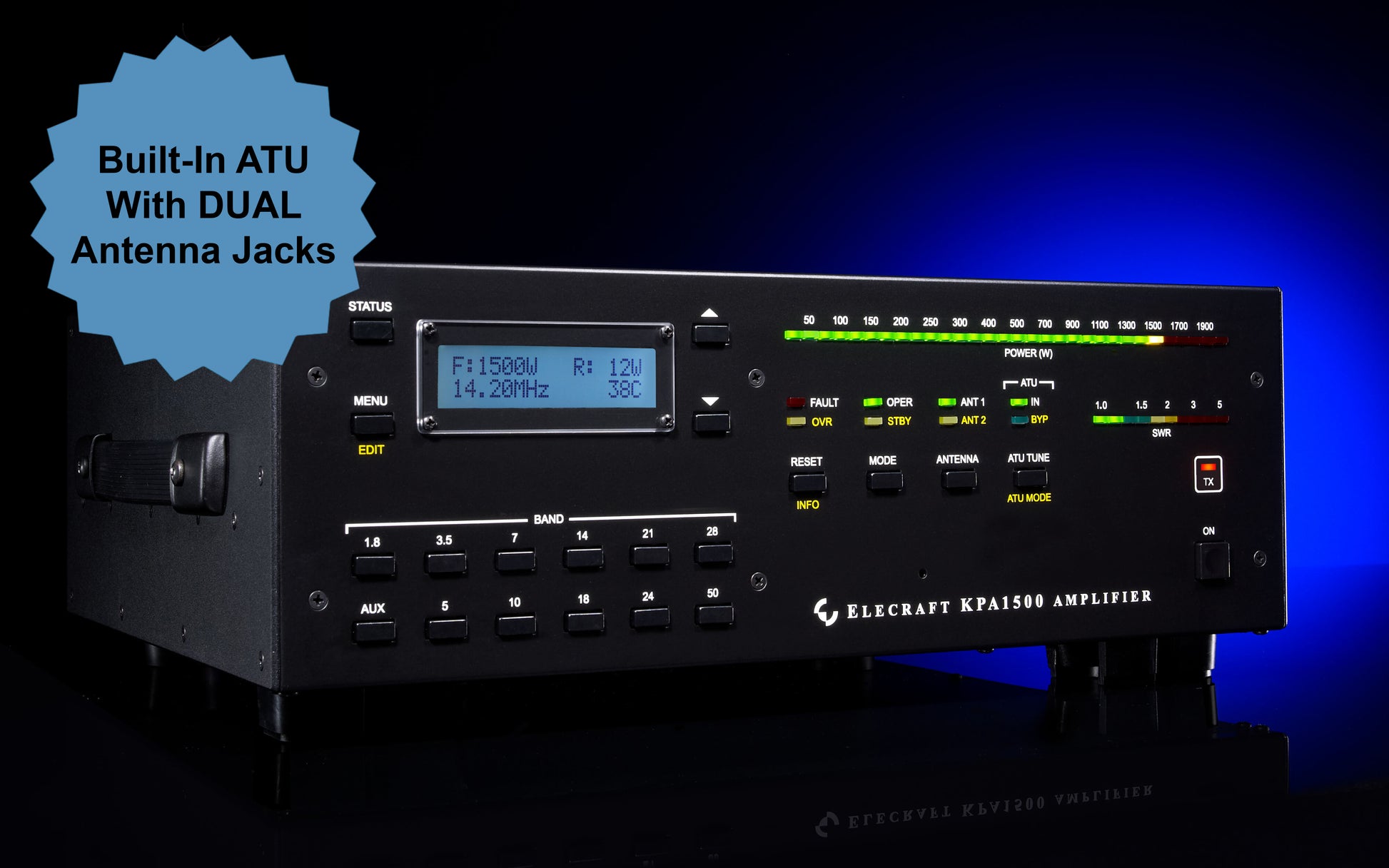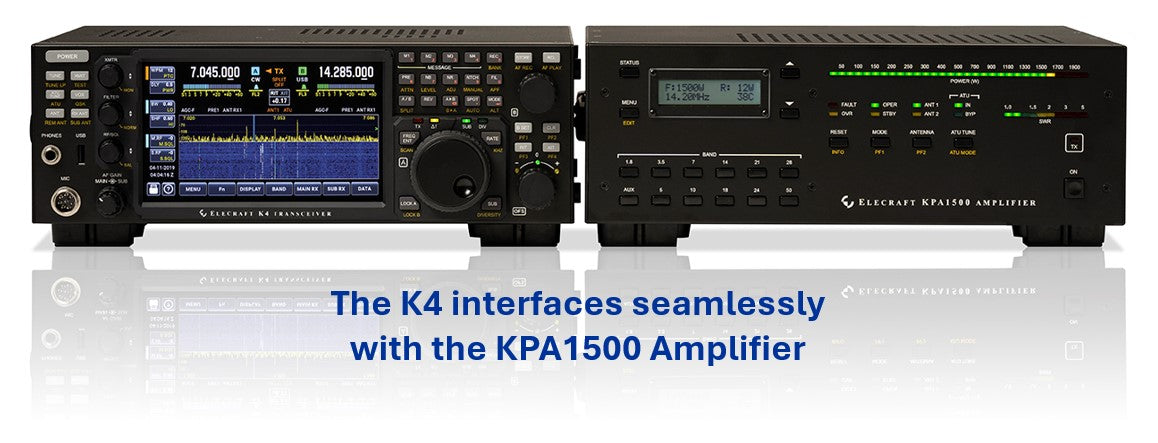KPA1500-F/EU W/INTERNAL ATU MODIFIED W/EUROPEAN POWER CABLE (SCHUKO),
Our new KPA1500 was designed with the serious operator in mind. Its no-nonsense front panel shows all important parameters at a glance, with a high-contrast 32-character LCD and fast, bright LED bar graphs.
KPA1500 Plays Well with Other Rigs! Just select the cable that goes with your rig under the Cable tab below. If you don't see your model listed, contact Support for assistance.
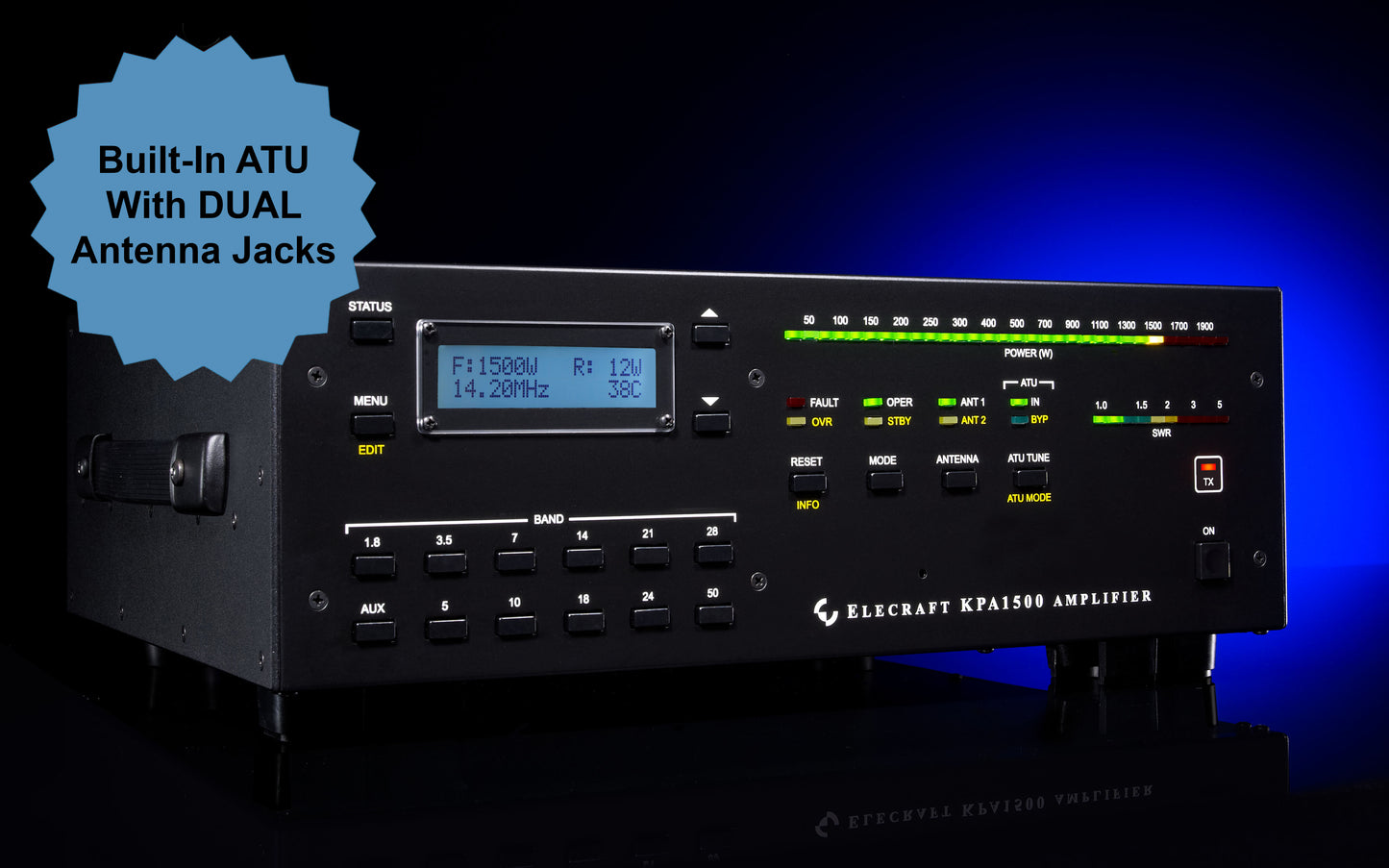
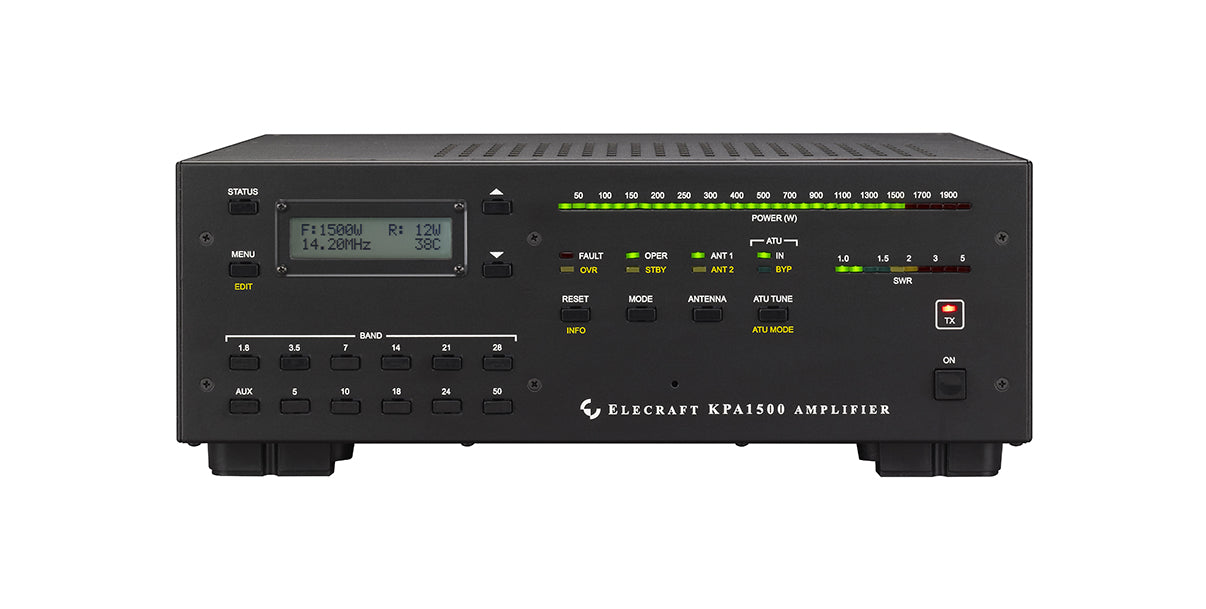
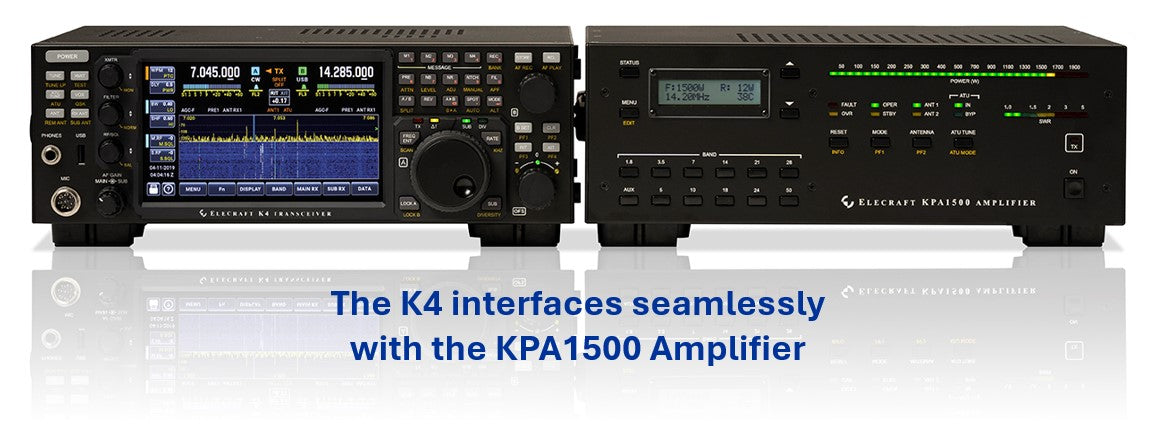
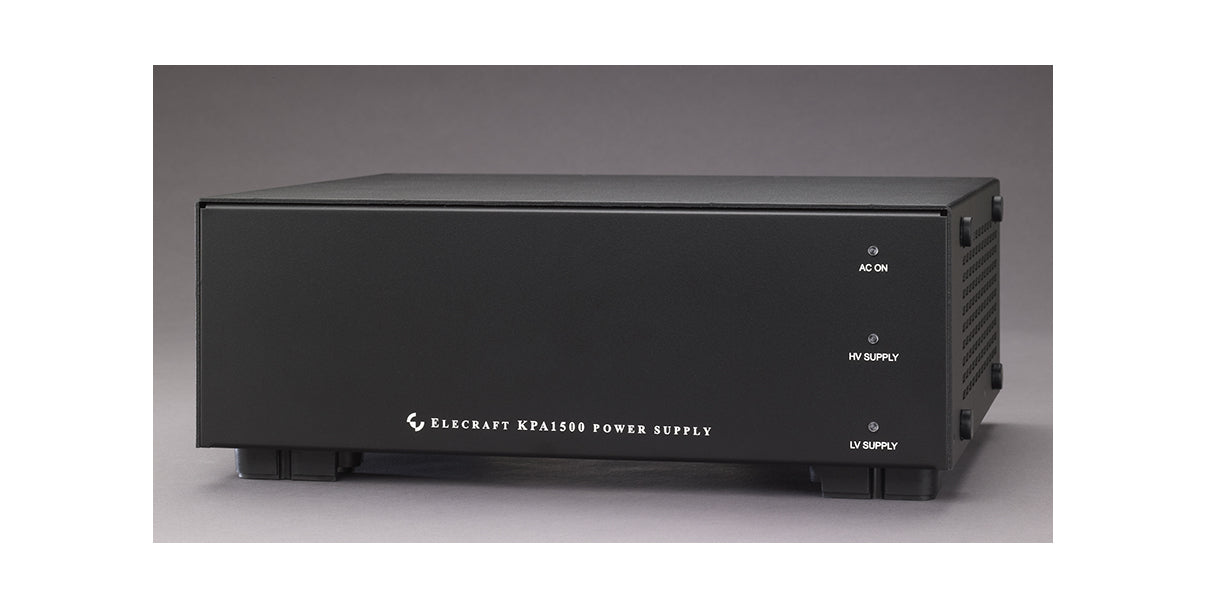
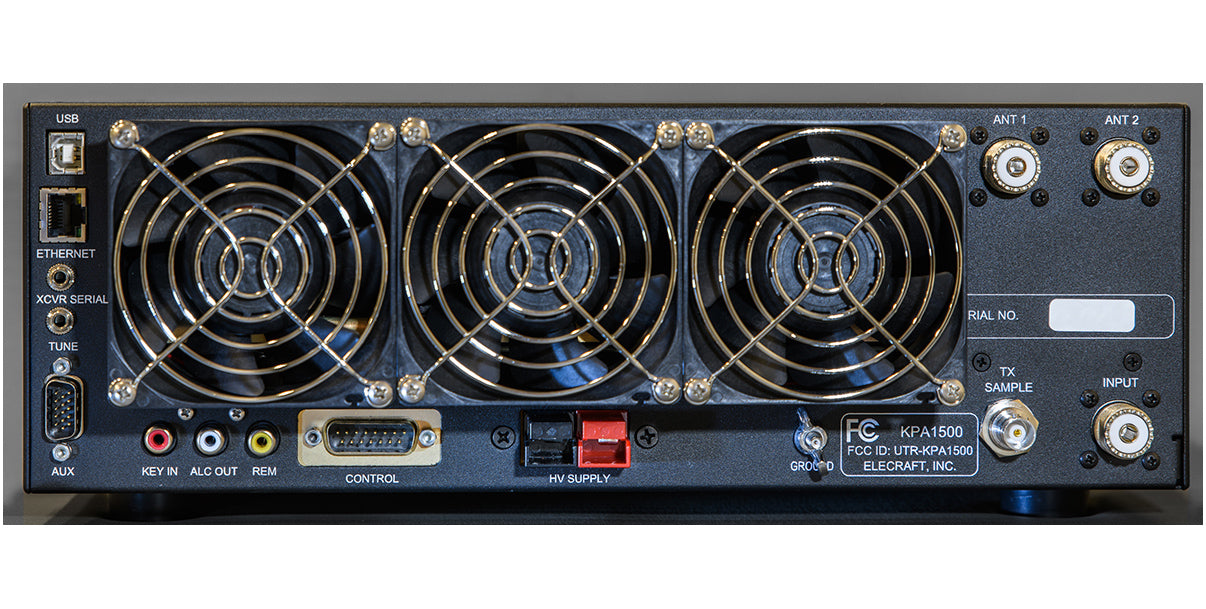
- Overview
- Specs
- Accessories
- Cables for Radio Brands/Models
- FAQ
- Manuals
- Price/Add To Cart
Overview
The KPA1500 solid-state amplifier won’t take over your entire desktop: it’s just 4.5 x 13.5 x 11.5” (HWD; 11.5 x 34 x 29 cm). The lightweight companion power supply can be placed on the floor or in any other convenient location.
The KPA1500's no-nonsense front panel shows all important parameters at a glance, with a high-contrast 32-character LCD and fast, bright LED bar graphs. Band switching is instantaneous, via control inputs or RF sensing. Protection and monitoring circuitry is extensive and foolproof, letting you focus on the job at hand — breaking pileups and overcoming the most difficult operating conditions. And it wouldn’t be an Elecraft amp without robust PIN-diode T/R switching. Like our KPA500, the KPA1500 offers fast QSK without a noisy relay.
The amplifier’s rugged internal ATU can handle full power with load SWR up to 3:1, while a wider matching range is allowed at lower power, including up to 10:1 in standby mode.
When it’s time to make waves, you can rely on the compact, quiet, highly integrated Elecraft KPA1500.
Specs
The following performance specifications are guaranteed only within the Amateur bands.
|
Frequency Range |
All Amateur bands from 1.8 to 29.7 MHz and 50 to 54 MHz |
|
Supply Voltage and Current |
195 to 250 VAC, 50/60 Hz up to 20A |
|
RF Deck Weight |
22 lbs. (10 kg) |
|
RF Deck Size |
Enclosure only, 4.5 x 13.5 x 11.5 in., HWD (11.5 x 34 x 29 cm) |
|
Power Supply Weight |
17 lbs. (7.5 kg) |
|
Power Supply Size |
Same as RF Deck: Enclosure only, 4.5 x 13.5 x 11.5 in., HWD (11.5 x 34 x 29 cm) excluding feet and protrusions |
|
Power Output |
1500 W PEP CW/SSB/Data |
|
Duty Cycle at 1500 Watts |
100% ICAS for 100% duty cycle modulation modes (FM, RTTY, FT8, JT65, etc.) 1.8-30 MHz: Maximum 5 minutes key down / Minimum 5 minutes receive (after 5 minute TX) 50 MHz: Maximum 50 seconds key down / Minimum 50 seconds receive |
|
Drive Power |
50-60 W, typical, for 1500 W output |
|
Input VSWR |
Less than 1.5:1 |
|
ALC Out |
Negative-going, adjustable |
|
Metering |
Power output, SWR (bargraph and on the LCD display), supply voltage and current, temperature, frequency band |
|
Heat Sink Temperature |
230° F (110°C), maximum |
|
Key In (Transmit Enable) |
+5V maximum, open circuit on receive, closed to ground on transmit (5 mA max.) |
|
Efficiency |
Approximately 50% |
Accessories
- KPAK3AUX: Connects the KPA500 or KPA1500 to K3/K3s, turns your K-Line into a complete, fully integrated 1500-watt transceiver.
Cables for Radio Brands/Models
Plays Well With Most Popular Rigs!
For some operators, sifting through all the technical details to connect one company’s radio to another company’s amp is not an easy feat. Certainly, with the investment in a high power linear amp and tuner, you’d want to get it right the first time. Elecraft has done the research to help you expand your station’s ability to run higher power, and we’ve made it easy to order a KPA1500 by providing cabling and instructions for some of the most popular rigs in shacks today.
Elecraft
| Cable # | Transceiver Model | Notes |
|---|---|---|
| E100416 (Included w/ Amp) | Phono Cable works with most radio models. Please Select additional cable(s) below based on desired operating mode. |
Standard Mode – Keying. Phono Keying Cable included with Amp. Amp/ATU selects band and freq. by using its internal frequency counter to measure TX freq. in this mode. Works with all radios with a keying output phono jack. |
|
KPAK3AUX |
K3, K3S, K4, K4D, K4HD |
Enhanced Mode - Full compatibility. Incl. Aux Cable set |
Cables for non-Elecraft Transceivers
Yaesu
| Cable # | Yaesu Model | Notes |
|---|---|---|
| E100416 (Included w/ Amp) | Phono Cable works with most radio models. Please Select additional cable(s) below based on desired operating mode. |
Standard Mode – Keying. Phono Keying Cable included with Amp. Amp/ATU selects band and freq. by using its internal frequency counter to measure TX freq. in this mode. Works with all radios with a keying output phono jack. |
| CBL-YAESUKEY | FT-817, FT818 |
Standard Mode – Keying. Incl. 8-pin MiniDIN to phono |
| CBL-YAE-BANDKEY | FT-920, FT990, FT1000 family, FT2000, FT5000, FT9000 family ("Large" radio) | Intermediate Mode - Radios w/BCD band data lines only. Incl. 8-pin DIN to DE15 |
| CBL-YAE-BKMINI | FT857, FT891, FT897, FT991 | Intermediate Mode-Radios w/BCD band data lines only. Incl. 8-pin MiniDIN to DE15 |
| CBL-YAE-BKDIN10 | FT450, FT1200, FTdx10B |
Intermediate Mode. 10-Pin MiniDIN to DE15 |
| CBL-YAE-BKDA15 | FT3000, FTdx101 Family | Intermediate Mode. DA15 to DE15 |
Icom
| Cable # | Icom Model | Notes |
|---|---|---|
| E100416 (Included w/ Amp) | Phono Cable works with most radio models. Please Select additional cable(s) below based on desired operating mode. |
Standard Mode – Keying. Phono Keying Cable included with Amp. Amp/ATU selects band and freq. by using its internal frequency counter to measure TX freq. in this mode. Works with all radios with a keying output phono jack. |
| CBL1500IC | Icom "large" radios: IC7300,7600,7610, 7700,7851,9100, IC746 | Enhanced Mode. 3.5mm CI-V cable for freq. data, (Phono Cable for keying, incl. w/Amp) |
| CBL1500IC-M | Icom "small" radios: IC703,706, 718, IC7000, 7100 | Enhanced Mode. Incl. CBL-ICOMKEY, and 3.5mm CI-V cable for freq. data. |
Flex
| Cable # | Transceiver Model | Notes |
|---|---|---|
| E100416 (Included w/ Amp) | Phono Cable works with most radio models. Please Select additional cable(s) below based on desired operating mode. |
Standard Mode – Keying. Phono Keying Cable included with Amp. Amp/ATU selects band and freq. by using its internal frequency counter to measure TX freq. in this mode. Works with all radios with a keying output phono jack. |
| CBL-FLEXKEY | 6000-family | Enhanced Mode. KXUSB cable for freq. data, (Phono Cable incl. w/Amp) |
Kenwood
| Cable # | Kenwood Model | Notes |
|---|---|---|
| E100416 (Included w/ Amp) | Phono Cable works with most radio models. Please Select additional cable(s) below based on desired operating mode. |
Standard Mode – Keying. Phono Keying Cable included with Amp. Amp/ATU selects band and freq. by using its internal frequency counter to measure TX freq. in this mode. Works with all radios with a keying output phono jack. |
| CBL-KENKEY | TS-140, 430, 440, 450, 570, 820, 830, 850, 930, 940, 950, 2000 | Standard Mode -Keying. Incl. 7-pin DIN to phono |
| CBL-KENKEY-M | TS-480 | Standard Mode – Keying. Incl. 8-pin MiniDIN to phono |
| CBL-KENSER1500 | Kenwood 580, 590, 890, 990 | Enhanced Mode - Keying & Freq. Data. Incl. DE9 to 3.5mm 7-Pin DIN and CBL-KENKEY |
Standard Mode = Keying (amplifier to transmit mode) Amp’s internal frequency counter auto-selects band and ATU frequency.
Intermediate Mode = Intermediate Mode-Radios w/BCD band data lines only. Keying plus band switching prior to TX. Amp’s internal frequency counter selects ATU frequency.
Enhanced Mode = Keying & Frequency Data from radio select amplifier band and ATU frequency prior to TX.
Don't see your radio? Contact us!
Free Shipping within the Continental U.S.
Visit here for KPA1500 App notes.
FAQ
Q: What is the KPA1500?
A: The KPA1500 is our 1500 watt PEP output, MF, HF and 6 Meter linear amplifier. It utilizes the latest LDMOS transistor technology to provide a robust desktop amplifier in a compact cabinet, with an included companion power supply that can be located off your desktop. The KPA1500 was designed with the serious operator in mind. Its no-nonsense front panel shows all important parameters at a glance, with a high-contrast 32-character LCD and fast, bright LED bar graphs. Band switching is instantaneous, via control inputs or RF sensing. Protection and monitoring circuitry is extensive and foolproof, letting you focus on the job at hand — breaking pileups and overcoming the most difficult operating conditions. And it wouldn’t be an Elecraft amp without robust PIN-diode T/R switching. Like our KPA500, the KPA1500 offers fast QSK without a noisy relay. The amplifier’s rugged internal ATU can handle full power with load SWR up to 3:1, while a wider matching range is allowed at lower power levels, including up to 10:1 in standby mode.
Q: Is the KPA1500 offered factory assembled and in kit form?
A: At this time, it's available in Factory-built form only.
Q: When will the KPA1500 be available for sale outside of North America?
A: The exact date will be determined when regulatory testing and certification (CE etc.) have been completed.
Q: Feature-wise, how does the KPA1500 compare to the KPA500?
| KPA500 | KPA1500 | |
|---|---|---|
| Maximum rated power, 160M to 6M | 500 watts | 1500 watts |
| AC power requirements | 120V or 240V AC | 240V AC only |
| Weight | 26 lbs/12 kg | RF Deck: 21.6 lbs/9.8 kg Power Supply: 15.6 lbs/7.1 kg Total: 37.2 lbs/16.9 kg |
| Power supply type | Linear | Switching In external cabinet, same size as RF Deck |
|
Very compact design (dim. shown are exclusive of feet, handle, and fans) |
4.0 x 10.8 x 10.0 inches 10.2 x 27.4 x 25.4 cm HWD |
4.5 x 13.5 x 11.5 inches 11.5 x 34 x 29 cm HWD |
| Full integration with K3/K3S | ✓ | ✓ |
| Automatic band select | ✓ | ✓ |
| Instant on | ✓ | ✓ |
| Fast, silent pin diode T/R switching | ✓ | ✓ |
| Built-in tuner option with dual antenna jacks | No Use KAT500 for up to 3 ANT connections |
✓ |
| RF sensing band change | ✓ | ✓ |
| Remote operation capable | ✓ | ✓ |
| Active overdrive/SWR protection | ✓ | ✓ |
| User-programmable switch functions and associated control outputs | No | PF1 & PF2 switches; up to 3 control signals |
| Compatible with nearly any transceiver | ✓ | ✓ |
Q: What do the KPA1500 control panel and rear panel look like?
A: The photo below shows the front panel controls. Note that the buttons use Elecraft’s familiar Tap or Hold functions for access to the most-used features.
Additionally, there is a Menu system for tailoring the KPA1500 settings to match your station requirements. Most of these need only be set up one time.

Below is a photo of the rear panel.

Q: What kind of connections does the KPA1500 provide for the transceiver and peripherals?
A: The rear panel of the KPA1500 includes the connectors described below.
- USB: Provides a virtual COM port for use with KPA1500 Utility and other computer-based control programs.
- Ethernet: For local and remote operation applications.
- XCVR SERIAL: For connections to Kenwood serial and Icom CI-V data streams to determine band and frequency.
- TUNE: Input that allows the KPA1500’s ATU to interact with an Icom remote tuner connection, found on many Icom transceivers. Can alternatively be used as a low-current on/off control output.
- AUX: A 15-pin jack for use with the K3/K3S and K4/K4D for Enhanced Mode operation. This fully integrates the KPA1500 with the either the K3/K3S or the K4/K4D
- KEY IN: Used with any transceiver to key the amplifier. Pulling KEY IN to ground causes the KPA1500 to be placed in transmit mode. (Normally pulled up to 5 volts DC through a 10 K resistor.)
- ALC Out: Provides a negative-going voltage to transceivers that require this feature. Elecraft radios do not require ALC to operate properly.
- REM: A 12-volt input signal for use in remote operation applications. This signal can be used to power on/off the KPA1500 with 12 volts DC applied to this connection.
- Control: Contains signals for the amplifier to communicate with its separate power supply.
- HV Supply: High voltage / high-current cable for the amplifier. Nominally 50 V, 50 A.
- Ground: For attaching the KPA1500 to station ground.
- TX Sample: Provides a low-level KPA1500 TX RF signal for sampling use by transceivers that support closed-loop pre-distortion techniques, e.g., Pure Signal. This low-level signal is taken directly from the amplifier’s directional coupler.
- RF Input: Connects to your transceiver’s RF output.
- ANT 1 and ANT 2: Dual RF output ports. When used with the internal 1500 watt tuner, the result of successful full-cycle tunes are remembered on a per-ANT port basis. This makes it easy to quickly QSY between antennas and recall the tuning elements needed immediately. Further, you can establish preferences for which ANT port to select when QSY’ing between bands. This allows you to pre-select what antennas you want assigned to each band.
Q: What does the power supply cabinet look like and how do I know it is on?
A: Here is what the power supply cabinet looks like. It is the same size as the KPA1500 RF deck. There are three LEDs to show power supply operating status. The power supply can optionally be placed some distance away from the RF deck, e.g., on the floor or in any well-ventilated location. The standard power supply cable is 5.5 feet long.
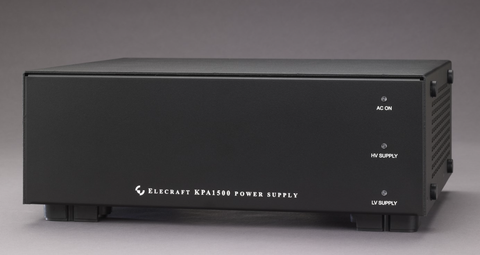
Q: Does the KPA500 stay in the product lineup now that the KPA1500 has been announced?
A: Yes. The KPA1500 and the KPA500 support different customer needs.
Q: Now that there’s the KPA1500, will there be continued enhancements for the KPA500?
A: Yes. Elecraft will continue to produce, support, and enhance the KPA500.
Q: What cables and accessories come in the box with the KPA1500?
A: While the AC power cable is permanently attached to the power supply cabinet, the plug end is adaptable to work with NEMA 6-20R receptacles in various parts of the world. Depending on your location, you will need to install a suitable NEMA 6-20P plug. Additionally, control interconnects cables, and a keying cable will ship with the KPA1500. The keying cable is an RCA-to-RCA cable for use with transceivers to enable the KPA1500 for transmitting.
Q: What are the options for the KPA1500?
A: Here’s an overview of the options:
| Option | Description | What do I need to order? |
|---|---|---|
| AC plug Europe | An AC plug suitable for the European markets | Specify at order time. |
| AC plug USA/Canada | An AC plug suitable for the North American markets | Specify at order time. |
| AC plug Australia/New Zealand | An AC plug suitable for the Australia and New Zealand markets | Specify at order time. |
| AC plug Asia | An AC plug suitable for the Asian markets | Specify at order time. |
| KPAK3AUX cable kit | A package of 2 adapters and a 15-pin cable for use with the K3/K3S series of radios. | KPAK3AUX |
Q: Does the KPA1500 include an internal tuner?
A: Yes. The KPA1500 the internal tuner system is part of the amplifier. The KPA1500 is not available without the internal tuner. It uses the same proven low-pass L-network technology as other Elecraft automatic antenna tuners.
Q: Are the RF deck and power supply cabinets the same size?
A: Yes. Each case measures 4.5 x 13.5 x 11.5 inches (41.5 x 34 x 29 cm) HWD, without fans, feet, and handle taken into account.
Q: How are the two cabinets connected?
A: There are two cables connecting the cabinets: 1) A +52 volt DC power cable using high-current, high-retention-force Anderson Power Pole connectors at each end. 2) A control cable containing the signals needed for the RF deck’s microcontroller unit (MCU) to monitor and control the power supply.
Q: How far apart may I place the Power supply and Amplifier cabinets?
A: The KPA1500 Control cables is 10 feet in length; suitable for use in a typical shack where the power supply may be placed in a more convenient location. The +52 volt heavy-gauge cable is 5.5 feet long. An extra cable can be connected to extend the length to about 11 feet. This is the maximum supported length for the Control and Power Cables.
Q: How is the AC cable made to accommodate international AC outlets?
A: You can specify the proper AC plug when purchasing the KPA1500. The KPA1500 is shipped with a NEMA 6-20P plug.
Q: What AC cable plug do I need to have?
A: The AC cable itself is installed into the Power Supply cabinet. The other end will have a NEMA 6-20P plug installed.
Q: What AC circuit ratings should I plan to have available to run the KPA1500?
A: You should plan to have a 200-240 volt, 20 amp run from the load panel to the KPA1500. Please tell your electrician to install a NEMA 6-20R type
Q: What is the amplifier circuit topology of the KPA1500?
A: The KPA1500 uses dual 1400 Watt LDMOS output devices configured in a push-pull output configuration.
Q: How is the transition from Receive to Transmit handled in the KPA1500?
A: Like all of Elecraft’s amplifiers, the KPA1500 uses PIN diode switching. This provides lightning-fast T/R while remaining silent, unlike less-reliable (and noisy) relay switching. To protect the amp and T/R switch, we use heavy-duty PIN diodes, very high reverse voltage, and virtually instantaneous detection of high SWR. All possible catastrophic load scenarios have been extensively tested.
Q: What kind of output devices are being used?
A: The KPA1500 uses two dual-section LDMOS devices, operating at 52 volts nominal. The use of two devices rather than one allows for improved thermal transfer, as discussed in the next item.
Q: How is heat managed in the KPA1500’s RF deck?
A: The KPA1500 has a large, custom heatsink extrusion and thick copper spreader, both optimized for our packaging. We also use two LDMOS devices rather than one, allowing heat to be laterally distributed more efficiently. There are three large, deep fans. The center fan is controlled independently so it can turn on first, at a lower speed. In many cases that's all the operator will ever hear. Only during high duty-cycle operation are the other two fans turned on. We then carefully manage the speed of all three to minimize noise while still ensuring excellent thermal performance.
Q: What is the expected duty cycle for the KPA1500?
A: 30 minutes at 100%. This should handle most any transmission needs for amateur radio use.
Q: How much drive power is required to achieve a rated output of 1500 watts?
A: 50 watts input, typical.
Q: Why is the KPA1500’s power supply in a separate enclosure?
A: Separating the power supply from the RF deck provides three advantages: (1) This dramatically reduces the size of the RF deck unit, which is typically located at the operating position. The two units are both very compact, allow ease of installation and handling. (2) The separate power supply can be cooled optimally by its fans and thermal management system, without contributing heat to the RF deck. (3) All high-voltage AC circuitry is located within the power supply cabinet, making RF deck maintenance safer and more convenient.
Q: What is the output level of the TX SAMPLE port?
A: Coupled from the amplifier output, the TX SAMPLE signal level will be compatible with Pure Signal requirements.
Q: Can the KPA1500 be used in an SO2R configuration?
A: Yes, provided that a suitable external switching unit is used. SO2R, done correctly, requires extensive path shielding, switching components, and control circuitry. Adding these internally would have increased the size and cost of the KPA1500 for all customers.
Q: Is there a convenient way to use two transceivers or external antenna switches with the KPA1500?
A: Yes. The KPA1500 provides two user-programmable switch functions, PF1 and PF2, as well as up to 3 on/off control outputs. These could be used to control an external (third-party) dual-rig switch, antenna switch, SO2R switch, etc. The amplifier’s firmware will be updated as required. Also, the KPA1500 provides multiple serial interfaces for sequencing and automation via radios or computer software.
Q: May the KPA1500 be operated outside the ham radio bands for MARS or other similar functions? Are there any limitations?
A: The KPA1500 can be used for MARS, Civil Air Patrol or other commercial applications requiring extended ranges outside of ham band allocations. Per FCC rules, however, the KPA1500 will not operate in the 11-meter band. Generally, we recommend operating the KPA1500 at 1000 Watts or lower for MARS frequencies and we _strongly_ recommend the internal tuner be used at all times for MARS operation. Plan on Training the Tuner on all MARS operating frequencies first before actual operation. This makes QSY between assigned frequencies fast.
Operation with the Elecraft K3/K3S & K4/K4D
Q: How is the KPA1500 connected to a K3/K3S or K4/K4D?
A: The KPAK3AUX cable kit provides all of the cables required. This cable kit will enable Enhanced Mode operation where the K3/K3S or the K4/K4D can interact with the KPA1500 for fully integrated operation. For instance, the K3/K3S or the K4/K4D can detect when the KPA1500 is in OPER or STBY mode and will adjust its RF output automatically to accommodate the lower RF drive required by the KPA1500. Then, it can return to ‘barefoot’ mode output when the KPA1500 is placed in STBY mode. Further, the band select buttons on the KPA1500 will control band selection on the K3/K3S and the K4/K4D, since the radio and linear amp are in constant communication. Likewise, the internal tuner can monitor the VFO frequency of the K3/K3S and the K4/K4D. This allows it to pre-select the tuning elements memorized from prior tuning cycles, supporting fast search-and-pounce operation.
Q: What is meant by “the internal tuner is rated up to 3:1 SWR at 1500 watts while it can handle up to a 10:1 SWR in amplifier bypass mode”?
A: The internal tuner in the KPA1500 will handle SWR levels inversely proportional to power output, primarily constrained by reflected power. That is, we rate the internal tuner at 1500 watts output while working into an antenna and transmission line system up to 3:1 SWR, and 500 watts at 10:1 SWR. When the amp is bypassed, the tuner can still be used just with the exciter, and the 10:1 limit applies.
Q: How will I know when to use the internal tuner? How does the KPA1500 handle high-SWR antennas?
A: The KPA1500 will try hard to work with high-SWR antennas. If the SWR is too high for your target power level, the amp will either drop back a few dB and keep on going or fault and go to bypass, depending on just how far over the allowed reflected power you get. The allowed forward power will vary with SWR. For the best transfer of RF power to the antennas system, plan on engaging the internal tuner when SWR rises above about 1.5:1.
Q: Is the internal antenna tuner operational in receive mode?
A: Yes. With some antennas, this may provide a small improvement in signal strength, or better rejection of adjacent bands, due to an optimal match between the antenna and the transceiver.
Q: Can the antenna tuner be easily bypassed?
A: Yes. The antenna tuner can be bypassed, separately from the amplifier itself, on a per-band/per-antenna basis.
Q: How many memories does the antenna tuner have? How are these used?
A: The KPA1500’s antenna tuner provides over 1600 frequency “bins” to effectively cover the entire 160 through 6-meter range. Each bin can store as many as 32 separate tuning solutions for the antenna tuner’s L-network, for a total of over 51,000 tuning solutions. This allows rapid re-tunes even in the case where more than one antenna can be used on a given band.
Q: May I use the KPA1500 with a KAT500?
A: There is no need to use a separate, external tuner since the KPA1500 already has an integrated, internal 1500-watt tuner.
Q: Will the KPA1500 work with the K3/0 Mini and Remote system?
A: Yes. The Elecraft K3 Remote System will be supporting the KPA1500 in future releases.
KPA1500 Operation with Other Popular Radios
Q: How do I hook up the KPA1500 to my non-Elecraft radio?
A: Please use this table to determine how you can hook up your radio.
- See notes below these tables defining Basic and Advance Mode operation.
Icom
| Model | Basic Mode | Enhanced Mode | Cables available from Elecraft? |
|---|---|---|---|
| IC-7610/7300 | ✓ Cable included with purchase | ✓ | Yes for Enhanced Mode |
| IC-746/756 series | ✓ Cable included with purchase | ✓ | Yes for Enhanced Mode |
| IC-7410/7600 series | ✓ Cable included with purchase | ✓ | Yes for Enhanced Mode |
Kenwood
| Model | Basic Mode | Enhanced Mode | Cables available from Elecraft? ** |
|---|---|---|---|
| TS-590 series | ✓ | ✓ | Yes for Basic Mode ** |
| TS-2000 | ✓ | ✓ | Yes for Basic Mode ** |
| TS-570 series | ✓ | ✓ | Yes for Basic Mode ** |
| TS-990 | ✓ | ✓ | Yes for Basic Mode ** |
| ** 3rd party custom cable maker available for Enhanced Mode | |||
Yaesu
| Model | Basic Mode | Enhanced Mode | Cables available from Elecraft? ** |
|---|---|---|---|
| FTdx5000 | ✓ | ✓ | Yes for Basic Mode ** |
| FTdx3000 | ✓ | ✓ | Yes for Basic Mode ** |
| FTdx1200 | ✓ | ✓ | Yes for Basic Mode ** |
| FTdx3000 | ✓ | ✓ | Yes for Basic Mode ** |
| FT-897/857 | ✓ | ✓ | Yes for Basic Mode ** |
| ** 3rd party custom cable maker available for Enhanced Mode | |||
Flex
| Model | Basic Mode | Enhanced Mode | Cables available from Elecraft? |
|---|---|---|---|
| 6700 | Cable shipped with the KPA1500 | Order Flex Key cable | Yes |
| 6600 | Cable shipped with the KPA1500 | Order Flex Key cable | Yes |
| 6500 | Cable shipped with the KPA1500 | Order Flex Key cable | Yes |
| 6400 | Cable shipped with the KPA1500 | Order Flex Key cable | Yes |
| 6300 | Cable shipped with the KPA1500 | Order Flex Key cable | Yes |
Q: What is meant by Basic and Enhanced connection modes?
A: Elecraft has 2 ways for linear amps and tuners to work with any transceiver: Basic and Enhanced Mode. Here's what that means:
Basic mode connection uses only the KEY signal and RF from the transceiver to ‘arm’ the KPA1500 for transmit when the transceiver goes into transmit. This approach uses the KPA1500’s ability to read the RF frequency on the VFO dial as you just begin to transmit. Basic mode, therefore, depends on just a brief sample of RF in order to quickly and smoothly change bands.
Enhanced mode connection uses one of various communication interfaces to determine what the VFO frequency or band is before the transceiver goes into transmit. While the communication method varies by the maker of the radio, they all serve to tell the KPA1500 how to prepare itself prior to transmitting. For DXers and Contesters, you can move quickly between frequencies in the same band or QSYing across bands.
Q: Will I be able to use the KPA1500 in a Remote station with Elecraft radios?
A: Yes. It has been designed to be operated remotely, supported by a variety of interfaces and a rich remote-control command set. Elecraft has released a free Remote Control Windows-based app to completely control the KPA1500 from anywhere in the world.
Q: Are there special cables needed to operate the KPA1500 remotely? How do I order them?
A: No. The only cables you may need will depend on the remote control approach you have chosen for your entire shack.

